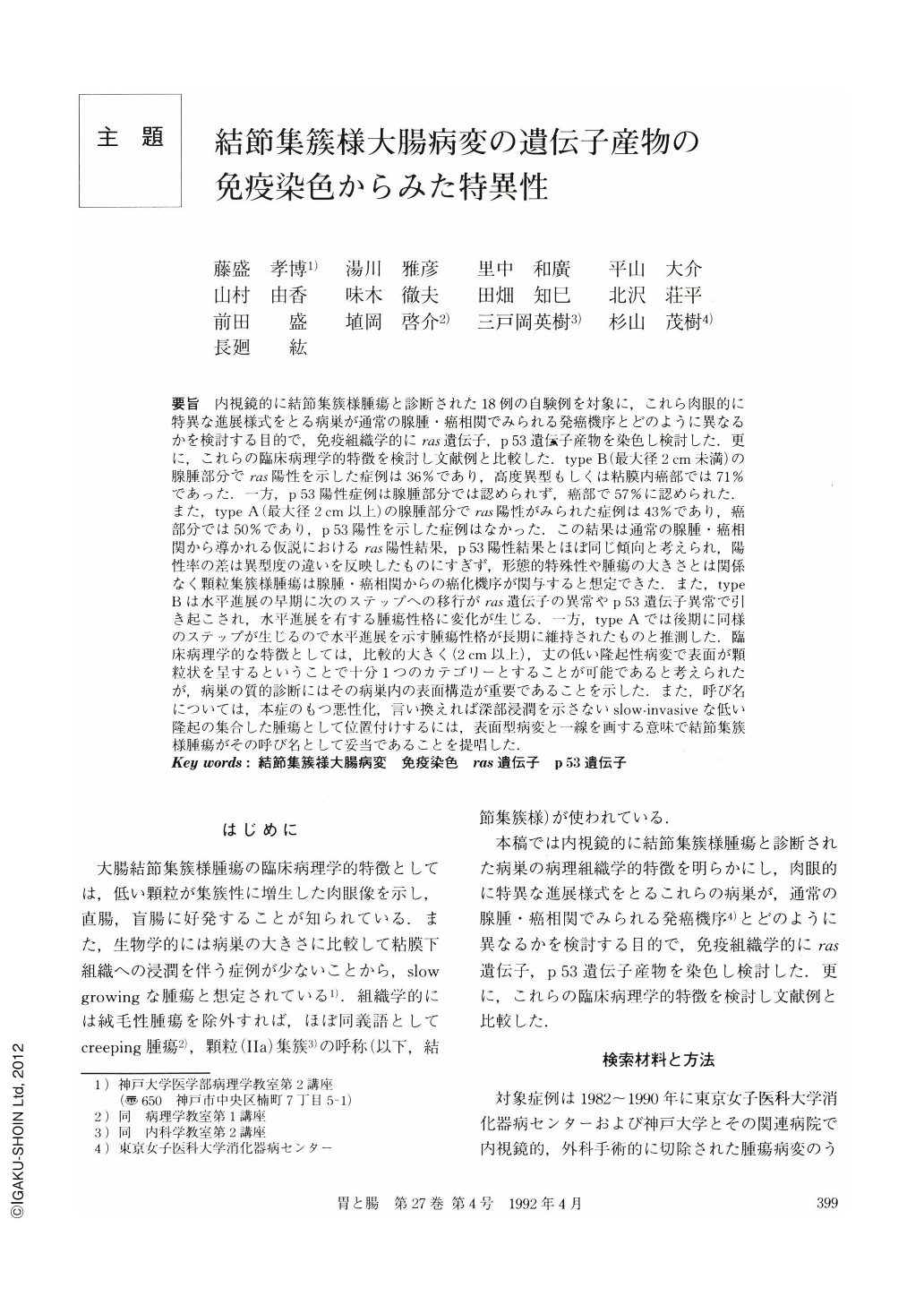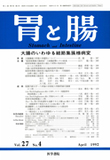Japanese
English
- 有料閲覧
- Abstract 文献概要
- 1ページ目 Look Inside
要旨 内視鏡的に結節集簇様腫瘍と診断された18例の自験例を対象に,これら肉眼的に特異な進展様式をとる病巣が通常の腺腫・癌相関でみられる発癌機序とどのように異なるかを検討する目的で,免疫組織学的にras遺伝子,p53遺伝子産物を染色し検討した.更に,これらの臨床病理学的特徴を検討し文献例と比較した.type B(最大径2cm未満)の腺腫部分でras陽性を示した症例は36%であり,高度異型もしくは粘膜内癌部では71%であった.一方,p53陽性症例は腺腫部分では認められず,癌部で57%に認められた.また,type A(最大径2cm以上)の腺腫部分でras陽性がみられた症例は43%であり,癌部分では50%であり,p53陽性を示した症例はなかった.この結果は通常の腺腫・癌相関から導かれる仮説におけるras陽性結果,p53陽性結果とほぼ同じ傾向と考えられ,陽性率の差は異型度の違いを反映したものにすぎず,形態的特殊性や腫瘍の大きさとは関係なく顆粒集簇様腫瘍は腺腫・癌相関からの癌化機序が関与すると想定できた.また,type Bは水平進展の早期に次のステップへの移行がras遺伝子の異常やp53遺伝子異常で引き起こされ,水平進展を有する腫瘍性格に変化が生じる.一方,type Aでは後期に同様のステップが生じるので水平進展を示す腫瘍性格が長期に維持されたものと推測した.臨床病理学的な特徴としては,比較的大きく(2cm以上),丈の低い隆起性病変で表面が顆粒状を呈するということで十分1つのカテゴリーとすることが可能であると考えられたが,病巣の質的診断にはその病巣内の表面構造が重要であることを示した.また,呼び名については,本症のもつ悪性化,言い換えれば深部浸潤を示さないslow-invasiveな低い隆起の集合した腫瘍として位置付けするには,表面型病変と一線を画する意味で結節集簇様腫瘍がその呼び名として妥当であることを提唱した.
In order to investigate the different mechanism between the creeping tumor and tumor induced by the usual adenoma-carcinoma sequence, products of ras gene and p 53 gene were stained immunohistologically in 18 creeping tumors which were diagnosed eudoscopically. Moreover, these clinicopathological characteristics were studied and compared with cases shown in literature. Ras-positivity was seen in 36% cases of type B adenoma (less than 2 cm of maximum diameter) region, and in 71% of the cancers. Ras-positivity was seen in type A adenoma (2 cm or more of maximum diameter) region in 29% cases and in the cancer region in 50% cases. No case showed p 53-positivity. These results were considered to be almost identical to the results of ras-positivity and p 53-positivity obtained from the usual adenoma-carcinoma sequence.
It was speculated that the difference of the positive rate reflected only differences of atypical degrees and the creeping tumors developed in the same mechanism of the usual carcinogenesis of the colon cancer, regardless of morphological specificity and size of tumor. Type B is induced by abnormalities of ras genes and p 53 genes in early shift to the next step, and tumor character which reveals horizontal extension are changed. On the other hand, it was assumed with respect to type A that the tumor character showing horizontal extension was maintained because similar steps occurred at a late stage for a long period. In terms of clinicopathological characteristics, the cases which have a relatively large (2 cm or more) and low elevated lesion with granular surface might be considered to be contained in one category. However, it was found that our type A cases had a lower complication rate of m, and sm cancer in comparison with cases shown in the literature. For quality diagnosis of the lesions, the surface structure of the lesion was considered to be important. Regarding the name, in order to place the tumor as one which does not show malignancy, namely, deep invasion, and is conglomerated with slow-invasive low elevation, we proposed to call it the creeping tumor with a different meaning from superficial type cancer.

Copyright © 1992, Igaku-Shoin Ltd. All rights reserved.


